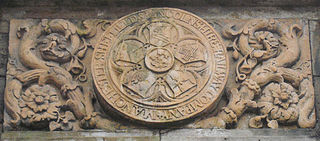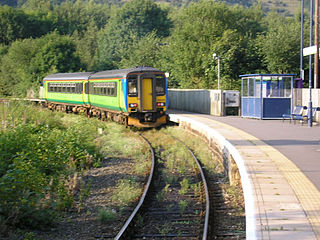
The London and North Western Railway was a British railway company between 1846 and 1922. In the late 19th century, the L&NWR was the largest joint stock company in the United Kingdom.

The Midland Railway (MR) was a railway company in the United Kingdom from 1844. The Midland was one of the largest railway companies in Britain in the early 20th century, and the largest employer in Derby, where it had its headquarters. It amalgamated with several other railways to create the London, Midland and Scottish Railway at grouping in 1922.

Ripley is a town in the Amber Valley borough of Derbyshire, England.

The British Rail Class 02 are a class of twenty 0-4-0 diesel-hydraulic shunting locomotives built by the Yorkshire Engine Company in 1960 and 1961 (D2860-D2869) for service in areas of restricted loading gauge and curvature such as docks. They had the door to the cab at the rear, with a railed veranda behind the cab; this feature was very unusual on British Rail locomotives, although it was used on many Yorkshire Engine Co. designs and is quite normal in North American practice.

The Manchester, Sheffield and Lincolnshire Railway (MS&LR) was formed in 1847 when the Sheffield, Ashton-under-Lyne and Manchester Railway joined with authorised but unbuilt railway companies, forming a proposed network from Manchester to Grimsby. It pursued a policy of expanding its area of influence, especially in reaching west to Liverpool, which it ultimately did through the medium of the Cheshire Lines Committee network in joint partnership with the Great Northern Railway and the Midland Railway.

The Cromford Canal ran 14.5 miles from Cromford to the Erewash Canal in Derbyshire, England with a branch to Pinxton. Built by William Jessop with the assistance of Benjamin Outram, its alignment included four tunnels and 14 locks.

The Midland Railway – Butterley is a heritage railway at Butterley, near Ripley in Derbyshire.
Matthew Kirtley was born at Tanfield, Durham. He was an important early locomotive engineer.

Ambergate railway station is a railway station owned by Network Rail and managed by East Midlands Railway. It serves the village of Ambergate in Derbyshire, England. The station is located on the Derwent Valley Line from Derby to Matlock, which diverges from the Midland Main Line just south of the station at Ambergate Junction.

The North Midland Railway was a British railway company, which opened its line from Derby to Rotherham (Masbrough) and Leeds in 1840.

Ironville in Derbyshire, England, was built about 1830 by the Butterley Company as a model village to house its workers. The population of the civil parish was 1,930 at the 2021 Census. It is situated between Riddings and Codnor Park.

LMS Princess Coronation Class 46233 Duchess of Sutherland is a steam locomotive built in 1938 for the London, Midland and Scottish Railway (LMS) at Crewe Works to a design by William Stanier. It is a 4-6-2 Pacific locomotive built as part of the LMS Coronation Class for its express passenger services, including the Royal Scot service from London to Glasgow.
The Sheffield, Ashton-under-Lyne and Manchester Railway was an early British railway company which opened in stages between 1841 and 1845 between Sheffield and Manchester via Ashton-under-Lyne. The Peak District formed a formidable barrier, and the line's engineer constructed Woodhead Tunnel, over three miles (4.8 km) long. The company amalgamated with the Sheffield and Lincolnshire Junction Railway and Great Grimsby and Sheffield Junction Railway companies, together forming the Manchester, Sheffield and Lincolnshire Railway in 1847.

The West Riding and Grimsby Railway was a railway company that promoted a line between Wakefield and Doncaster, in Yorkshire, England. There was also a branch line connection from Adwick le Street to Stainforth, which gave access towards Grimsby. The company was promoted independently, but it was sponsored by the Manchester, Sheffield and Lincolnshire Railway and the Great Northern Railway, and became jointly owned by them.

The A610 is an A-road in England, which runs from Nottingham to Ambergate, where it joins the A6.
Oldham Clegg Street railway station was the Oldham, Ashton-under-Lyne and Guide Bridge Junction Railway station that served the town of Oldham in northwest England, it had three associated goods stations.
The Lancashire, Derbyshire and East Coast Railway (LD&ECR) was built to connect coalfields in Derbyshire and Nottinghamshire with Warrington and a new port on the Lincolnshire coast. It was a huge undertaking, and the company was unable to raise the money to build its line. With the financial help of the Great Eastern Railway it managed to open between Chesterfield and Lincoln with a branch towards Sheffield from 1896. Despite efforts to promote tourist travel, the passenger business was never buoyant, but collieries were connected to the line, at first and in succeeding years. The Great Eastern Railway, and other main line companies, transported coal to the southern counties, and the company's engines took coal to Immingham in great quantities. The company had a fleet of tank engines.

Butterley railway station is a preserved railway station on the Heritage Midland Railway - Butterley in Derbyshire.
Cuthbert (Chip) Hamilton Ellis FRSA was an English railway writer and painter. He was an Associate of the Institution of Locomotive Engineers and a Fellow of the Royal Society of Arts
The Widnes loop was a 5 miles 2 chains (8.1 km) railway line which served the town of Widnes, England from 1879 to 2000.













